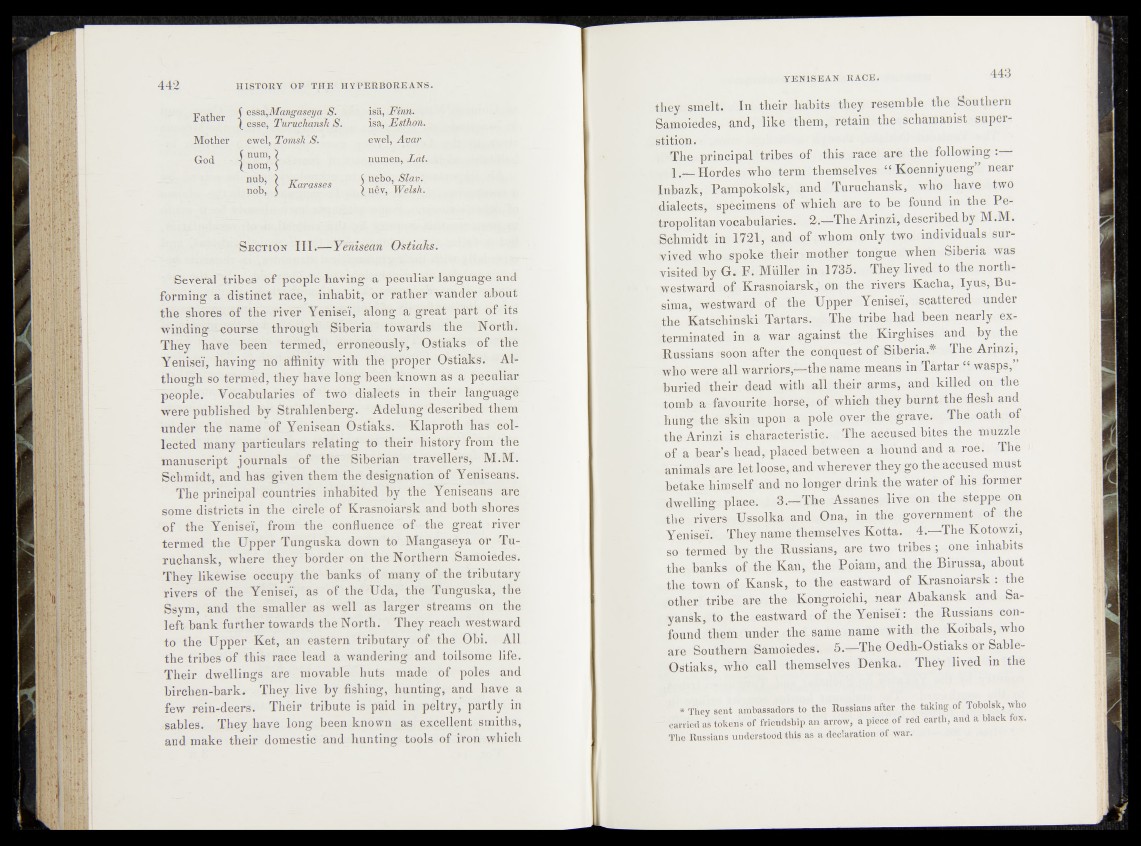
Father 5 eBè&^Mangaseya S.
\ esse, Turuckansh S.
-s isâ, Finn.. .
is&yEsthon.
Mother ^ ewe),, Tomsk S. , ewel, Avar K
God f num, ?
1 nöm, 5 nurnepjivöf.
nob* } Karqsses C nebo, /S?a».‘
(. nêv, Welsh.
S ec tio n I I I .—Yenisean Ostiaks.
' Several .tribes of people having a peculiar language and
forming a distinct'race^fidhabitj or rather'* wander about
the shores of the river Yenisei', along a great part of its*
winding: eouhrsë ^ through Siberia towards the r-iNó'rth.
They havé béeiï termed, erroneously;1 Ostiaks ^of^iSe
Yenisei, having ho affinity with thé projlèr Ostiaks. Although
so termed, they have long beeh5known as a* pëéu'Mar
pèople. VoeabularieT of two dialeots ■ i#Wh eir IttógfögS
were published by Strahlenberg. Adelung: described thlfii:
under thé name ofJYenisèàn Ostiaks. Klaproth -dads^oP
lected many particulars relating to their history from thé
manuscript journals óf thé Siberian^*! travellers, M^D.
Schmidt, and has given them the'designation, of Yepiseans.
The principal countries inhabited by th e 1Yéôpl8lSwh‘
some districts in the circle of Krasnoïarsk ah^T-beth ®h%reS
of the Yenisei, from the confluence of the great river-
termed the Upper Tunguska down to Mangasèya Or-Tu-
ruchansk, where they border on the Northern Samoiedes.
They likewise occupy the banks,of many of the tributary
rivers of the Yenisei, as of the 'Uda, 'the Tunguska, the
Ssym, and the smaller as well as larger streams on the
left bank further towards the North. They reach westward
to the Upper Ket, an eastern tributary: of the Obi. All
the tribes of this race lead a wandering and toilsome life.
Their dwellings are movable huts made of poles and
birchen-bark. They, live by fishing, hunting, and have a
few rein-deers. Their -tribute is paid in peltry, partly in
sables. They have long been known as excellent smiths,
and make their domestic- and hunting tools of iron which
they*smelt. In their habits they resemble the Southern
Samoiedes, and, like them,1 retain the schamanist super-
stition. ■
The principal tribes of this race are the following
1.—Hordes , who. term themselves “ Koenniyueng” near
Inbazk, Pampokolsk, .and Turuchansk, who have two
dialects, .'specimens*,of which are to be found in the Pe-
-feropolitan vocabularies. ^2.—The Arinzi, described by M.M.
Schmidt in 1721, and of whom only two individuals survived.
wbo»spoke «theim mother*:. tongue when Siberia was
visited by G. EïiMiÜer in 1735. They lived to the northwestward
toS Krasnoiarskhdn the rivers Kacha, Iyus, Bu-
sima, westward.:?of ■ the Upper .Yenisei, scattered under
•the Katschinski Tartars.- The* tribe had heenhnearly exterminated^
n a war against d>he Kirghispsj 'andmby^ the
Russians isoom after the?;.conquest of Siberia,^ . The Arinzi^
who werp all warriors—the name means in Tartar “ wasps,”
buried their, dead with all itheir arms, and killed; on the
M©«ib a favourite.tosev.M.which they burnt the flesh and
hüng^the*skinjjupon a‘ pofev'Over the grave. The oath of
, the Arlpzif isi characteristic. The accusec^ites the muzzle-
kjof a bear’s, head,.plaoed,hetw een a ^und.and .a.-roeii The
animals are; Let loose, and whenever thepgo the accused must
i§iakef«himself and no longer, drink the water .of his former
dwelling place.. , 3irr«The lA s s a n e ^ i^ q p the steppe on
the riversr .Ussolka and On a,, in the,?göyernment of the
Yenisei They name th em s e lf Kotta. 4.—The Kotowzi,
so termed by the Rushans, are two tribes# one inhabits
the^hanks of the Kan, tbe Poiam, and the Birussa, about
the town of Kansk* tptthe eastward of Krasnoiarsk : the
other tribe are the ^Kongroichi, hear Abakansk and Sa-
yansk, to the eastward ofetheiYeniseï: the Russians confound
them under,(-the. same name withothe Koibals, who
are Southern Samoiedes* : 5.—The Qedh-Ostiaks or Sable-
Ostiaks, who call •themselves Denka. They lived in the
* They sent ambassadors to'the Russians after the taking of Tobolsk, who
- eaWièé as tokens of'friendship an arrow, a piece of red earth, and a black fox.
Tlie Russians understood this as a declaration of war.